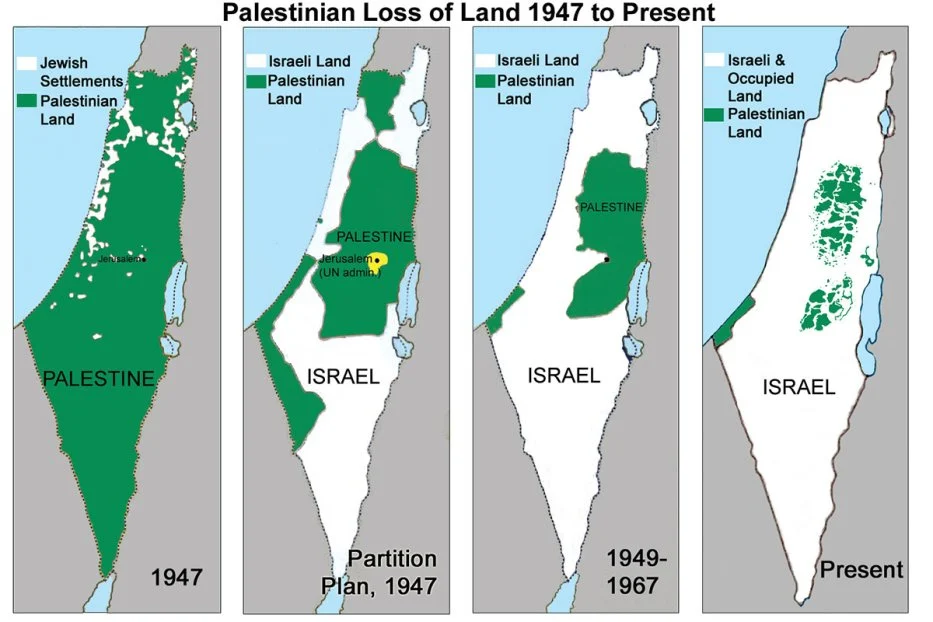
The Israeli-Palestinian conflict has captured global attention for decades, with one question frequently arising: Why has Israel not handed land to the Palestinians based on the 1947 UN Partition Plan for Palestine? To understand this issue, one must explore the origins of the conflict, the fate of the UN plan, and the deeply rooted historical, political, and security-related factors that shaped Israel’s refusal to implement it.
The UN Partition Plan of 1947: A Historical Turning Point
In 1947, the United Nations General Assembly passed Resolution 181, which proposed dividing British-ruled Mandatory Palestine into two independent states—one Jewish and one Arab. The plan allocated:
- 55% of the land to a Jewish state,
- 45% to an Arab state,
- Jerusalem and Bethlehem as international zones.
Jewish leaders accepted the partition, viewing it as a legal foundation for establishing the state of Israel. However, Palestinian Arabs and surrounding Arab countries rejected the plan, claiming it favored Jews—who made up about one-third of the population—and unjustly dispossessed the Arab majority.
The Arab Rejection and War of 1948
After the UN approved the plan, violent clashes erupted between Jewish and Arab communities. When Israel declared independence on May 14, 1948, five Arab countries—Egypt, Jordan, Iraq, Syria, and Lebanon—invaded Israel, marking the start of the 1948 Arab-Israeli War.
Israel not only survived the attack but also gained more territory than what the UN had assigned. By the end of the war, Israel controlled 78% of Mandatory Palestine, far more than the 55% allotted. Meanwhile, Jordan occupied the West Bank, and Egypt took control of Gaza. No Palestinian state materialized.
This war fundamentally altered the regional map and rendered the UN Partition Plan obsolete.
Why Israel Doesn’t Adhere to the UN Partition Plan

1. The Plan Lost Legal and Political Relevance
The Arab states’ rejection of the partition and their subsequent military action voided the agreement in practice. Israel argues that war—not negotiation—determined the region’s current boundaries. With no Arab recognition of the plan and no Palestinian state formed under it, the proposal effectively collapsed.
2. Israel Views Its Current Borders as Legitimate
Israel considers its current territory a product of its self-defense and a right gained after surviving a war it did not initiate. The 1948 war reshaped the region, and international diplomacy—especially post-war armistice agreements—established Israel’s territorial boundaries in reality.
3. Security Concerns Drive Israeli Policy
Israel cites deep security concerns as a key reason for not giving up territory. The 2005 Gaza disengagement, where Israel withdrew all troops and settlers, led to Hamas seizing control and launching thousands of rockets into Israeli cities. That event convinced Israeli leaders that territorial withdrawal can lead to increased attacks, especially if no strong, peaceful Palestinian authority is in place.
4. No Unified Palestinian Leadership
Since the split between Fatah in the West Bank and Hamas in Gaza, Israel has refused to engage in final-status negotiations without a single, unified Palestinian leadership. Hamas does not recognize Israel’s right to exist and has engaged in armed conflict with it repeatedly. This division within Palestinian politics complicates any negotiations over land.
5. Israeli Settlements Change the Landscape
Over the decades, Israel has constructed more than 130 settlements in the West Bank and expanded Jewish neighborhoods in East Jerusalem. Over 600,000 Israelis now live in these areas. These settlements are integrated with Israeli infrastructure, making a return to the 1947 map virtually impossible from a logistical and political perspective.
6. Jerusalem Is a Non-Negotiable Capital
Although the UN proposed internationalizing Jerusalem, Israel captured East Jerusalem in 1967 and declared the entire city its capital. It sees Jerusalem—home to key Jewish, Christian, and Islamic religious sites—as indivisible. On the other hand, Palestinians claim East Jerusalem as the future capital of their state, creating a core sticking point in peace talks.
Modern Diplomatic Efforts Replace the 1947 UN Partition Plan
Since the UN Partition Plan failed, global efforts have focused on a different framework: a two-state solution based on the pre-1967 borders, which reflect territories Israel occupied during the Six-Day War (West Bank, Gaza, and East Jerusalem).
Key efforts include:
- The Oslo Accords (1993–1995), which aimed to create a roadmap toward a Palestinian state.
- The Camp David Summit (2000) and Annapolis Conference (2007), both of which failed to reach a final agreement.
- Continued involvement from the United States, European Union, and Arab states.
Despite these efforts, no lasting peace has been achieved, and deep mistrust and recurring violence have frozen the diplomatic process.
Why Returning to the 1947 UN Partition Plan Isn’t Realistic
Even the Palestinian Authority no longer advocates for the 1947 partition. Instead, it focuses on gaining recognition and sovereignty based on the 1967 borders. Several factors make a return to the 1947 plan unworkable:
- Demographic changes: Jewish and Arab populations have expanded and relocated across original partition lines.
- Established Israeli infrastructure: Settlements and security zones are deeply entrenched.
- Changed political context: The 1947 plan assumed peaceful co-existence, which decades of violence and failed peace efforts have made extremely difficult.
Conclusion: A Plan Overtaken by History
Israel has not given land to Palestinians according to the 1947 UN Partition Plan because the plan collapsed almost immediately after its adoption. Arab rejection, regional war, and shifting geopolitical dynamics reshaped the region before it could take effect.
Today, Israel views its borders as the outcome of survival and legitimacy. Security concerns, Palestinian political fragmentation, and the growth of Israeli settlements have further hardened its stance. The UN Partition Plan remains a historical document, not a practical foundation for peace.
Any future solution will need to reflect current realities, not outdated maps. Only through mutual recognition, security guarantees, and diplomatic compromise can Israelis and Palestinians hope to reach a peaceful and sustainable resolution.

